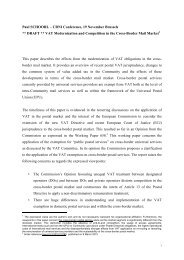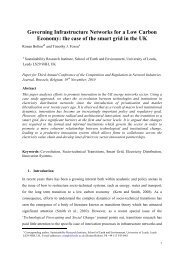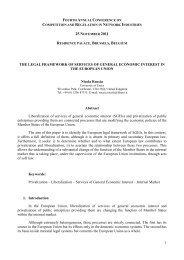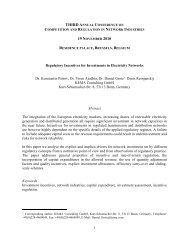Non-discriminatory Third Party Access to the Gas Transmission ...
Non-discriminatory Third Party Access to the Gas Transmission ...
Non-discriminatory Third Party Access to the Gas Transmission ...
Create successful ePaper yourself
Turn your PDF publications into a flip-book with our unique Google optimized e-Paper software.
discrimination. 83 It matters little which description is used; <strong>the</strong> ‘principle of equal treatment’ or<br />
<strong>the</strong> ‘principle of non-discrimination’. 84 They are simply two tag-names for a single general<br />
principle of EU law, which prohibits both treating similar situations differently and treating<br />
different situations in <strong>the</strong> same way, unless <strong>the</strong>re are objective reasons <strong>to</strong> do so. 85 The general<br />
principle of equal treatment means that <strong>the</strong>re should be ‘no discrimination’ whatsoever, ei<strong>the</strong>r<br />
directly or indirectly. 86 <strong>Non</strong>-<strong>discrimina<strong>to</strong>ry</strong> TPA as a specific expression of <strong>the</strong> principle of<br />
equality must not be interpreted <strong>to</strong>o strictly in <strong>the</strong> view of <strong>the</strong> general principal of equality/nondiscrimination.<br />
It should not go any fur<strong>the</strong>r than necessary for achieving <strong>the</strong> true purpose of non<strong>discrimina<strong>to</strong>ry</strong><br />
TPA. As mentioned before, non-<strong>discrimina<strong>to</strong>ry</strong> TPA aims <strong>to</strong> create competition<br />
between gas supply undertakings in order <strong>to</strong> ultimately deliver lower prices, more choice and<br />
differentiated services for consumers as <strong>the</strong> internal energy market aims <strong>to</strong> deliver. The latter<br />
implies <strong>the</strong> following: as long as treating similar system users differently and treating different<br />
system users in <strong>the</strong> same way is not contrary <strong>to</strong> <strong>the</strong> objectives of <strong>the</strong> internal market in natural<br />
gas, it is not forbidden. Following from this is that <strong>the</strong> TGD and <strong>the</strong> SGR do not strive <strong>to</strong> reach<br />
absolute equality of system users. <strong>Non</strong>-<strong>discrimina<strong>to</strong>ry</strong> TPA aims at equality of system users <strong>to</strong><br />
<strong>the</strong> extent necessary <strong>to</strong> achieve <strong>the</strong> objectives of <strong>the</strong> internal market in natural gas. Applying <strong>the</strong><br />
foregoing within <strong>the</strong> EU gas transmission context it means that <strong>the</strong> concept of non-<strong>discrimina<strong>to</strong>ry</strong><br />
TPA involves:<br />
Treating similar system users similar and treating different system users different <strong>to</strong> <strong>the</strong><br />
extent necessary in order <strong>to</strong> achieve <strong>the</strong> objectives of <strong>the</strong> internal market in natural gas,<br />
unless <strong>the</strong>re are objective reasons for unequal treatment.<br />
83 Cityworks (Case C-439/06) [2008], paragraph 42, VEMW and O<strong>the</strong>rs (Case C-17/03) [2005], paragraphs 42 <strong>to</strong> 46.<br />
84 Ibid.<br />
85 Ibid.<br />
86 P. v S. (Case C-13/94) [1996], paragraph 17 and Dimossia Epicheirissi Ilektrismou (Case C-147/95) [1977],<br />
paragraphs 25-29, Kathleen Hill and Ann Staple<strong>to</strong>n (Case C-243/95) [1996], paragraph 44 and De Weerd (Case C-<br />
343/92) [1994], paragraph 33. <strong>Non</strong>e<strong>the</strong>less, sometimes indirect discrimination can be objectively justified.<br />
Distinguishing between direct and indirect discrimination is only of importance in <strong>the</strong> case of non-discrimination<br />
rules where <strong>the</strong> objectives are laid down explicitly in <strong>the</strong> non-discrimination rule itself (i.e. non-discrimination on <strong>the</strong><br />
basis of nationality as far as employment is concerned). In <strong>the</strong> case of nationality discrimination, <strong>the</strong> CJEU has<br />
consistently held that <strong>the</strong> equal treatment rule prohibits not only overt/direct discrimination by reason of nationality<br />
but also all covert/indirect forms of discrimination which, by <strong>the</strong> application of o<strong>the</strong>r distinguishing criteria, lead in<br />
fact <strong>to</strong> <strong>the</strong> same result. It is o<strong>the</strong>rwise only if those provisions are justified by objective considerations independent of<br />
<strong>the</strong> objective of <strong>the</strong> non-discrimination rule itself (i.e. nationality of <strong>the</strong> workers), and if <strong>the</strong>y are proportionate <strong>to</strong> <strong>the</strong><br />
legitimate aim pursued. See: Sotgiu (Case 152/73) [1974] and O’Flynn (Case C-237/94) [1996], paragraph 19). Since<br />
<strong>the</strong> objectives of <strong>the</strong> non-<strong>discrimina<strong>to</strong>ry</strong> TPA rule are not laid down explicitly in <strong>the</strong> non-discrimination rule itself;<br />
all forms of discrimination are contrary <strong>to</strong> EU gas law.<br />
16







